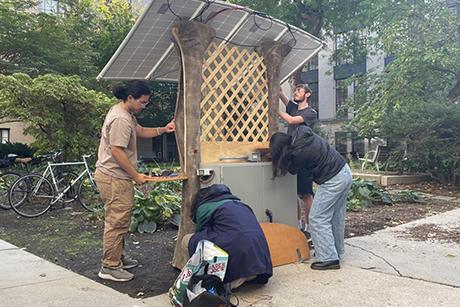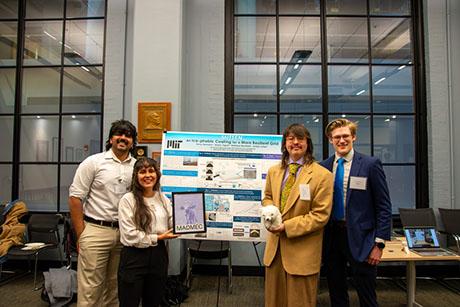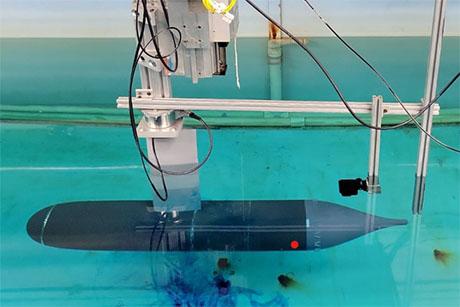Undergraduate Spotlight: Katy Olesnavage
Graduating Senior Lays Groundwork for Locating Fresh Water Sources

Photo credit: MIT News Office
by Nancy Adams
Submarine groundwater discharge, or SGD, describes water flowing underground from coastal aquifers into the ocean.
Though SGD may contain recirculated seawater, it is most often associated with fresh water discharge, water that can be tapped for the benefit of local needs, both domestic and agricultural. And in Cyprus, or any region where part of the demand for fresh water is being met by energy- and cost-intensive desalination, proper management of fresh water resources is a high priority.
“The environmental aspect is what initially drew me to it,” says Katy Olesnavage, a graduating senior in MechE whose senior thesis on the subject earned her the 2012 Horn Award. “The fact that it had components of electrical engineering, programming, and aeronautical engineering were just added benefits. I have gotten a lot more out of working on this interdisciplinary project than I could have if I had worked on something that fell strictly within the bounds of mechanical engineering, where I am most comfortable.”
Indeed, locating SGD, which has been described as akin to looking for a needle in a haystack, is outside most students’ comfort zones. But a review of the literature and consultation with researchers working with SGD pointed Olesnavage toward a promising approach. Because the temperature of groundwater is constant year round while the temperature of the ocean changes with the seasons, one way to locate groundwater flow into the ocean is by identifying temperature anomalies on the ocean’s surface using aerial thermal imaging. These images can then be used to locate favorable areas for further in situ salinity testing to verify the presence of fresh water SGD.
Before traveling to the eastern Mediterranean in search of SGD, Olesnavage field-tested her procedures and equipment closer to home at Quonochontaug Pond, on the Rhode Island coast. Using existing thermal images of the pond provided by Dr. Matthew Charette of the Woods Hole Oceanographic Institution (Charette is a currently funded MIT Sea Grant investigator), Olesnavage selected sites for further investigation. At the locations where thermal imaging indicated the possible presence of SGD, she successfully measured salinity levels with a conductivity, temperature, and depth sensor, and used the results to analyze the relationship of anomalous temperatures to the presence of fresh groundwater discharge.
Armed with confidence in her method, Olesnavage was ready for Cyprus. The Cyprus Institute organized the team and equipment Olesnavage needed and provided expertise on the issues of SGD in the eastern Mediterranean. And, perhaps equally important, staff at The Cyprus Institute had connections in the local fishing community, which, using less high-tech methods such as observation of surface bubbles and sightings of farm animals drinking at certain locations along the ocean’s edge, was able to help her pinpoint a likely spot to begin the investigation. Using an infrared camera attached to a piloted aircraft, Olesnavage and her Cypriot colleagues then captured the thermographic images of coastal waters needed to confirm likely outflows of SGD.
These images were not always easy to come by—both nature and airport security managed to slow them down on occasion. Some days, takeoff had to be postponed due to morning fog or airport security procedures, which ate up the few hours during which data could be collected before the sun’s heat eliminated any sea-surface temperature differences. Through patience and perseverance, they got enough thermal images to identify areas for in situ salinity measurements. The methodology and findings of Olesnavage’s thesis have set the stage for testing along the island’s coast.
The Cyprus Institute could not be happier with Olesnavage’s work. Dr. Costas Papanicolas, president of the Cyprus Institute, comments, “The findings reported by Katy pave the way for the next phase of this important research project, which is to identify, quantify, and actually harvest some of the fresh water that is flowing or seeping into the sea.” In this next phase, they have plans to use unmanned aerial vehicles (UAVs) that can more efficiently and accurately collect the needed thermal imaging. The Cyprus Institute has several UAVs, a unique resource in the area, which it hopes will be functional and ready for implementation in this project by late spring 2012 when rainfall, and thus SGD, is highest.
Papanicolas goes on to praise Olesnavage’s work: “Katy’s superb work exemplifies some of the best aspects of the collaboration between MIT and The Cyprus Institute: young, promising scientists performing cutting-edge research to address one of the world’s most acute problems.”![]()


